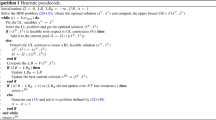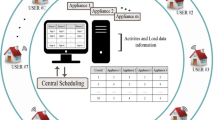Abstract
Active supply–demand interactions in a smart grid are essential for reducing grid power imbalance which is important for the security and efficiency of power supply. A key element to the success of such interactions is the proper pricing strategy. The latest game-theory-based dynamic pricing methods require information exchanges not only between the supply and demand sides, but also among individual buildings, since they make decisions for one building’s demand response based on/influenced by operations of the others. However, in practical applications in which a number of buildings are considered, the latter information exchanges are extremely difficult due to the concerns of privacy, communication complexity and high computation load. Therefore, this chapter proposed a genetic algorithm-based dynamic pricing method for improving bi-directional interactions with reduced power imbalance, which does not require information exchanges among individual buildings. In this chapter, at the demand side, targeting at minimizing daily electricity cost, a non-linear programming-based demand response control is performed in individual buildings at a dynamic price given by the grid operator genetic algorithm optimizer. Targeting at reducing grid power imbalance, the genetic algorithm optimizer is used by the grid operator to search for a better dynamic price based on the aggregated demand response results. Such interaction will continue until the grid power imbalance cannot be further reduced. The impacts of demand elasticity are also investigated on performance improvements. The proposed pricing method can be used in practical applications to improve dynamic pricing of a smart grid for reduced grid power imbalance and thus increased operation efficiency.
Access this chapter
Tax calculation will be finalised at checkout
Purchases are for personal use only
Similar content being viewed by others
References
(DOE), T. U. S. D. O. E (2018) Commercial reference buildings [Online]. Available: https://www.energy.gov/eere/buildings/commercial-reference-buildings [Accessed 03 Feb 2019]
Al Irsyad MI, Halog A, Nepal R (2019) Renewable energy projections for climate change mitigation: an analysis of uncertainty and errors. Renew Energ 130:536–546
Boßmann T, Staffell I (2015) The shape of future electricity demand: exploring load curves in 2050s Germany and Britain. Energy 90:1317–1333
CONSULTING SB (2010) Power smart pricing 2009 annual report
Cui B, Dong J, Munk J, Mao N, Kuruganti T (2018) A simplified regression building thermal model of detached two-floor house in US for virtual energy storage control
Cui B, Fan C, Munk J, Mao N, Xiao F, Dong J, Kuruganti TJAE (2019) A hybrid building thermal modeling approach for predicting temperatures in typical, detached, two-story houses 236:101–116
Cui B, Gao D-C, Xiao F, Wang SJAE (2017) Model-based optimal design of active cool thermal energy storage for maximal life-cycle cost saving from demand management in commercial buildings 201:382–396
Cui B, Wang S, Yan C, Xue X (2015) Evaluation of a fast power demand response strategy using active and passive building cold storages for smart grid applications. Energy Convers Manage 102:227–238
Dehnavi E, Abdi H (2016) Optimal pricing in time of use demand response by integrating with dynamic economic dispatch problem. Energy 109:1086–1094
Dutta G, Mitra K (2017) A literature review on dynamic pricing of electricity. J Oper Res Soc 68:1131–1145
Ellison JF, Tesfatsion LS, Loose VW, Byrne RH (2012) Project report: a survey of operating reserve markets in us iso/rto-managed electric energy regions. Sandia Natl Labs Publications, p 1000
Fang X, Misra S, Xue G, Yang D (2012) Smart grid—the new and improved power grid: a survey. IEEE Commun Surv Tutor 14:944–980
Faruqui A, Palmer J (2012) The discovery of price responsiveness–a survey of experiments involving dynamic pricing of electricity
Gao D-C, Sun Y (2016) A GA-based coordinated demand response control for building group level peak demand limiting with benefits to grid power balance. Energy Build 110:31–40
Gao D-C, Sun Y, Lu Y (2015) A robust demand response control of commercial buildings for smart grid under load prediction uncertainty. Energy 93:275–283
Hassan R, Radman G (2010) Survey on smart grid. IEEE SoutheastCon 2010 (SoutheastCon). In: Proceedings of the 2010. IEEE, pp 210–213
Hledik (2009) How green is the smart grid? Electr J 22:29–41
Huang P, Huang G, Sun Y (2018a) A robust design of nearly zero energy building systems considering performance degradation and maintenance. Energy 163:905–919
Huang P, Huang G, Sun Y (2018b) Uncertainty-based life-cycle analysis of near-zero energy buildings for performance improvements. Appl Energy 213:486–498
Huang P, Sun Y (2019a) A clustering based grouping method of nearly zero energy buildings for performance improvements. Appl Energy 235:43–55
Huang P, Sun Y (2019b) A robust control of nZEBs for performance optimization at cluster level under demand prediction uncertainty. Renew Energy 134:215–227
Huang P, Wu H, Huang G, Sun Y (2018c) A top-down control method of nZEBs for performance optimization at nZEB-cluster-level. Energy 159:891–904
Institute EPR (2016) EPRI load shape library 5.0 [Online]. Available: http://loadshape.epri.com/ [Accessed]
Kakran S, Chanana S (2018) Smart operations of smart grids integrated with distributed generation: a review. Renew Sustain Energy Rev 81:524–535
Kirschen DS, Strbac G, Cumperayot P, De Paiva Mendes D. (2000) Factoring the elasticity of demand in electricity prices. IEEE Trans Power Syst 15:612–617
Lu R, Hong SH, Zhang X (2018) A dynamic pricing demand response algorithm for smart grid: reinforcement learning approach. Appl Energy 220:220–230
Ma L, Liu N, Wang L, Zhang J, Lei J, Zeng Z, Wang C, Cheng M (2016) Multi-party energy management for smart building cluster with PV systems using automatic demand response. Energy Build 121:11–21
Mathworks (2019) Matlab documentation: fmincon [Online]. Available: https://ww2.mathworks.cn/help/optim/ug/fmincon.html?#busp5fq-6 [Accessed June 18 2019]
Meng F-L, Zeng X-J (2013) A stackelberg game-theoretic approach to optimal real-time pricing for the smart grid. Soft Comput 17:2365–2380
Momoh JA (2009) Smart grid design for efficient and flexible power networks operation and control. In: Power systems conference and exposition. PSCE'09. IEEE/PES, 2009. IEEE, pp 1–8
Nojavan S, Zare K, Mohammadi-Ivatloo B (2017) Optimal stochastic energy management of retailer based on selling price determination under smart grid environment in the presence of demand response program. Appl Energy 187:449–464
Powell MJ (1978) A fast algorithm for nonlinearly constrained optimization calculations. Springer, Numerical analysis
Saghezchi FB, Saghezchi FB, Nascimento A, Rodriguez J (2014) Game theory and pricing strategies for demand-side management in the smart grid. In: Communication systems, networks & digital signal processing (CSNDSP), 2014 9th international symposium on, 2014. IEEE, pp 883–887
Simshauser P, Downer D (2014) On the inequity of flat-rate electricity tariffs. In: AGL applied economic and policy working paper, p 41
Srinivasan D, Rajgarhia S, Radhakrishnan BM, Sharma A, Khincha H (2017) Game-theory based dynamic pricing strategies for demand side management in smart grids. Energy 126:132–143
Sun Y, Wang S, Xiao F, Gao D (2013) Peak load shifting control using different cold thermal energy storage facilities in commercial buildings: a review. Energy Convers Manage 71:101–114
Wang Q, Zhang C, Ding Y, Xydis G, Wang J, Østergaard J (2015) Review of real-time electricity markets for integrating distributed energy resources and demand response. Appl Energy 138:695–706
Xue X, Wang S, Sun Y, Xiao F (2014) An interactive building power demand management strategy for facilitating smart grid optimization. Appl Energy 116:297–310
Xue X, Wang S, Yan C, Cui B (2015) A fast chiller power demand response control strategy for buildings connected to smart grid. Appl Energy 137:77–87
Zhang S, Huang P, Sun Y (2016) A multi-criterion renewable energy system design optimization for net zero energy buildings under uncertainties. Energy 94:654–665
Zhang S, Sun Y, Cheng Y, Huang P, Oladokun MO, Lin Z (2018) Response-surface-model-based system sizing for nearly/net zero energy buildings under uncertainty. Appl Energy 228:1020–1031
Author information
Authors and Affiliations
Corresponding author
Editor information
Editors and Affiliations
Rights and permissions
Copyright information
© 2023 The Author(s), under exclusive license to Springer Nature Singapore Pte Ltd.
About this chapter
Cite this chapter
Sun, Y., Huang, P. (2023). Dynamic Pricing for Improving Bi-Directional Interactions with Reduced Power Imbalance. In: Zhang, X., Huang, P., Sun, Y. (eds) Future Urban Energy System for Buildings. Sustainable Development Goals Series. Springer, Singapore. https://doi.org/10.1007/978-981-99-1222-3_18
Download citation
DOI: https://doi.org/10.1007/978-981-99-1222-3_18
Published:
Publisher Name: Springer, Singapore
Print ISBN: 978-981-99-1221-6
Online ISBN: 978-981-99-1222-3
eBook Packages: Social SciencesSocial Sciences (R0)




